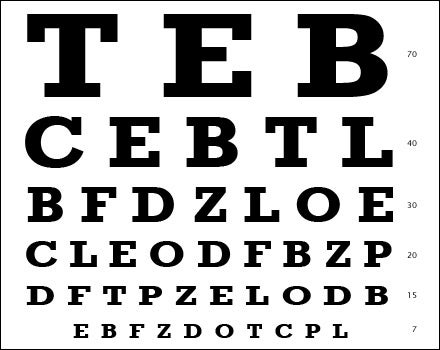You go to the gym three times a week to build muscle tone. You run grueling intervals to boost lactate threshold. You even skip dessert in order to stay in top shape. Nice work. But before you pat yourself on the back, answer this: Are you ignoring your most important athletic asset? Every move you make, from bombing singletrack to shooting hoops, starts with vision. What’s more, your eyes can be trained to perform better. To be precise, it’s your visual skills, not vision itself, that improve. Only glasses, contacts, or surgery can correct poor eyesight. But follow our advice on eye care and exercise and you will, quite literally, see the difference.
I Am a Camera
Checklist
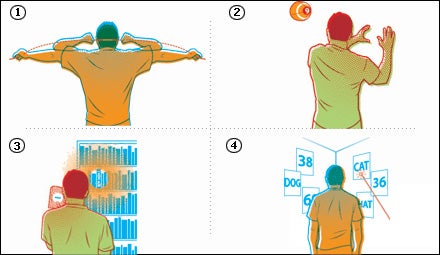
As you look at this magazine, light is reflected off the page and onto your
CORNEA (1)
, a windowlike covering that acts like the glass of a camera lens. The adult cornea is only about half a millimeter thick yet contains more nerve endings than any other place in the body.
The
LENS (2)
focuses, bends, and refracts the light. Crystalline and fragile, it’s suspended within the eye by tiny guy wires called
ZONULES (3)
. The younger you are, the better your lens is able to change shape to adjust for near or distant vision. As you age, the lens stiffens like an arthritic joint, which causes some of the eye problems people commonly experience after age 50 or so.
The colored part of your eye is the
IRIS (4)
. Eye color is determined by microscopic pigment cells called
MELANIN (5)
. The color, texture, and patterns of each person’s irises are as unique as fingerprints.
The iris is embedded with tiny muscles that dilate to constrict the
PUPIL (6)
, which, like a camera’s aperture, regulates the amount of light that enters. When it’s dark outside, your pupils expand to gather as much light as possible. In bright light the pupil constricts.
After light passes through the pupil, it lands on the
RETINA (7)
, a multilayer sensory tissue that lines the back of the eye. The retina acts like the film in a camera. It contains millions of
PHOTORECEPTORS (8)
that capture light rays and convert them into electrical impulses, which are sent to the brain via the optic nerve. The brain develops those impulses into the images you perceive.
Eye movement is controlled by the
EXTRAOCULAR MUSCLES (9)
, a collection of six muscles that direct your eyesight left to right and up and down—helping you track a ball or scan downriver.
EYELIDS (10)
and eyelashes are your first line of defense against dirt and debris. With each blink, the eyelids spread a film of oil, water, and mucus evenly across the eye’s surface.
Focus, Group!
Training
Q & A
Is it safe to hike at altitude if you’ve had eye surgery?Depends. If you’re one of the guinea pigs who underwent radial keratotomy (RK) in the eighties and nineties, then you could experience a refractive shift (blurred vision) above 16,000 feet. But RK has largely been replaced by LASIK surgery, which is safer, because lasers are more precise than a diamond-blade scalpel when shaping the cornea. In 2003, five Everest climbers who had undergone LASIK surgery reported no visual changes up to 26,400 feet. Three of them noted perfect vision on top, while two had minor blurring that improved upon descent.
Founder of the Visual Fitness Institute, in Vernon Hills, Illinois, ophthalmologist Barry L. Seiller has developed vision-improvement programs for the U.S. Ski Team, major league baseball teams, and elite tennis players. Vision training improves performance by increasing the speed with which you gather and process visual information. Chase Headley, 23, a third baseman in the San Diego Padres organization, says that, as a result of the training, “I see the ball sooner, and it decreases my reaction time.” Use the exercises here, adapted from Seiller’s program and optometrist Thomas Wilson’s SportsVision: Training for Better Performance, to improve your own visual skills. Practice four times per week, devoting three minutes to each drill. Reduce frequency as you master the skills.
SKILL: Hand-Eye Coordination (Refer Fig. 1) Precise and speedy hand-eye coordination improves performance in every sport, from climbing to tennis.
DRILL: Thread the Spaghetti Have a friend hold a drinking straw horizontally about 16 inches from your face. While looking straight ahead (not at your hands), try to thread two pieces of uncooked spaghetti simultaneously into opposite ends of the straw. Repeat the drill, varying the distance and position of the straw.
SKILL: See-Think-React (Refer Fig. 2) High-speed sports require split-second reactions to visual cues. Kayakers and mountain bikers see a rock and process the visual information, then execute moves to avoid the obstacle. The faster you are at the former, the easier the latter becomes.
DRILL #1: Eye on the Ball Gather a few footballs (Nerfs work well). Label the tip of each ball with a different number. Have a friend throw you a ball; before you catch it, call out the number on the tip.
DRILL #2: Beanbag Toss Have a partner stand a few feet behind you and toss a beanbag past you on one side or the other, but within reach. As he throws, your partner calls “left” or “right.” Look to that side and catch the bag. Advanced: Stare straight ahead to improve peripheral vision as well.
SKILL: Near/Far Focusing (Refer Fig. 3) Cycling, skiing, and all ball sports require the ability to focus on close-up objects (rocks, moguls, blistering first serves) and then quickly shift to objects that are far away (a bend in the trail, trees downslope, the net).
DRILL: Rapid Eye Movement Stand ten feet away from a bookcase. Hold a book or magazine (opened to a page of small text) at eye level, several inches from your face. Read a few words of the magazine and then look up and read the title off the spine of a book on the shelf. Switch back and forth betweenreading small, close text and distant titles. The goal is quickness and accuracy.
SKILL: Peripheral Vision (Refer Fig. 4) Quarterbacks and point guards are often praised for their “vision”—or benched for their lack of it. Whether for pickup games or crowded club rides, you need to be aware of what’s happening around you as well as in front of you.
DRILL: Look Wide Print out several papers with words and numbers in 72-point type. Tape the papers randomly to the walls in the corner of a room. Have a friend point to various pages with a laser pointer, and call out the words and numbers—while staring straight into the corner. For maximum benefit, vary your distance from the corner (three to six feet).
Tinted Love
Protection
Q & A: Chris Carmichael
Where should I look to avoid crashes in the peloton?Fight the urge to watch the wheel in front of you. Keep your eyes focused 30 riders ahead, so you can see sudden turns and braking well in advance. Out front? Keep your eyes trained 30 to 50 feet ahead, letting your peripheral vision track riders to the sides. In the aero position, don’t let eye-muscle fatigue cause you to drop your gaze or raise your head into the wind. If your eyes tire easily, it’s likely a problem with bike fit.>CHRIS CARMICHAEL’S LATEST BOOK, 5 ESSENTIALS FOR A WINNING LIFE, IS OUT NOW.Owner's Manual: Your Eyes
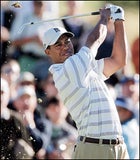
Choosing the correct sunglass lens—amber versus yellow, for instance—is the key to protecting your eyes without diminishing vision. “Since a tinted lens decreases the amount of light getting into the eye, the athlete may perceive this as more comfortable, but the lenses may be limiting what they’re able to see,” says Robert Bailey Jr., an ophthalmology instructor at Thomas Jefferson University, in Philadelphia. Color preference is still subjective, but use this chart as a guide to help pick the right lens for the light conditions and sport. Always choose a shatterproof lens that filters both UVA and UVB rays.
ROSE
Makes details pop when light is flat and enhances scenery against blue backgrounds Best for: urban settings, driving, snow, and watersports
ORANGE
Ups the contrast and shadow definition in medium light conditions Best for: skiing, ball sports
YELLOW
Increases clarity in low-light conditions Best for: cycling, mountain biking, running
GREEN
In overcast conditions, enhances perception of yellows and reds Best for: driving, fishing, golf, whitewater kayaking
TEAL
A highly specialized lens that makes yellow stand out Best for: tennis
BLUE/GRAY
Reduces glare and preserves natural colors Best for: sea kayaking, ocean fishing, surfing
BROWN/AMBER
Increases depth perception and cuts glare on sunny to partly cloudy days; reduces eyestrain caused by haze Best for: all sports
GRAY
Blocks bright sun while allowing you to see colors in their most natural state Best for: running, cycling, hiking, watersports
CLEAR
Provides physical eye protection in low light Best for: 24-hour bike races, night skiing, and adventure racing
Vision Quest
Lasik Pros and Cons
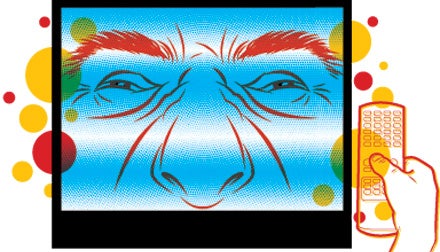
Laser eye surgery is the new performance-enhancing drug among pro athletes. The appeal: It’s legal—and the results are beyond dramatic. Tiger Woods, once considered legally blind without his contacts, underwent laser eye surgery in 1999 and walked out with 20/15 vision. (Translation: He can now read from 20 feet away something that a 20/20 person can’t read from more than 15 feet away.) Oh, and he went on to win six straight titles. Pitcher Greg Maddux had surgery and went nine-and-one in his next 11 games. We’re guessing you’re interested now. First, consider these factors:
HOW BAD IS YOUR EYESIGHT? LASIK has proven most effective for people with minor to moderate nearsightedness and astigmatism. Opt out if you’re under 20 (since your eyes are still developing) or have an eye-related medical condition like diabetes.
POST-SURGERY: LASIK is popular because it’s fast, painless, and offers a quick recovery time (24 hours to return to work, four weeks to return to sports, and four months to climb Kilimanjaro).
CAVEATS: Complications range from dry eyes and light sensitivity to detached retinas and debilitating infections. Overall, the incidence of serious complications is low, less than 1 percent. Some doctors argue the risk from wearing contacts long-term is worse.
COST: Ignore the LASIK coupons for $500 per eye. This is not a haircut. A typical procedure at a reputable laser eye center will run you about $1,900 per eye.
Screen Test
Office Upgrade
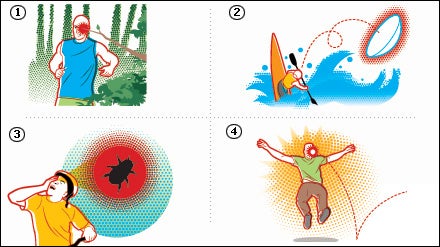
Does sitting too close to the television or computer monitor really ruin your eyes? No. But long hours in front of either display can cause eyestrain, which in turn can slow your near-to-far focusing—decreasing your athletic performance. Think about it: At your desk, your visual field is limited to your computer screen, coffee mug, phone, and everything else that’s three feet in front of you. Sit there too long and your eyes begin to forget that there’s more to focus on. Then your vision pays the price when you go for a ride or play soccer after work. To reduce daily eyestrain, follow these tips from the National Institute of Occupational Safety and Health.
(1) Increase the text size on documents and Web sites. Text should be comfortable to read without squinting or straining. (In your Web browser, click on View and choose Text Size.)
(2) Black text on a white background is the best color combination. If you’re working on a Web site or presentation, choose the highest-contrast dark-on-light color option.
(3) Fine-tune the brightness on your computer screen. A white background should appear clean, not gray. If it glows like a fluorescent light, dim it.
(4) Every 30 minutes, look away from your computer screen and focus on a distant object for five to ten seconds (look across the room or out the window). Set a desktop alarm as a reminder, and don’t ignore it.
(5) If you need to look back and forth between a printed page and your computer screen, place paperwork on a stand adjacent to the monitor. Make sure the pages are well lit.
(6) Ambient lighting should be about half of what’s found in most offices. Eliminate excess exterior light by closing drapes or blinds. Reduce interior lighting by using low-intensity or fewer lightbulbs and fluorescent tubes. Position your monitor so that windows are to the left or right of it, instead of in front or back.
(7) Bright white walls contribute to glare. If possible, paint your office a darker color in a matte finish.
(8) All LCD screens today have antiglare properties. If your CRT monitor doesn’t, get an aftermarket antiglare screen cover.
A Poke in the Eye
Common Injuries and Treatments

Stats
>EST. 1934>ACREAGE 522,051
>VISITORS 9,289,215(2006)
Vision-damaging injuries are rare but frightening. Here’s how to gauge the severity of an accident—and how to treat it.
ABRASION (Refer Fig. 1)
Problem: You’re trail running and you don’t see a branch until it whacks you in the eye. Most likely, your cornea has been scratched.
Treatment: “This is one of the most common sports eye injuries we see,” says ophthalmologist Elizabeth F. Baze, director of residency training at Baylor College of Medicine’s Cullen Eye Institute. Most of the time, abrasions cause watery eyes, light sensitivity, and a scratchy sensation. If symptoms are minor and your vision isn’t blurred, patch the eye with gauze and allow it to heal for 24 to 48 hours. If your vision is affected or the abrasion is extremely painful, patch it and see a doctor.
LOST CONTACT (Refer Fig. 2)
Problem: A Class V rapid sends you and your kayak through the rinse cycle. When you emerge, you’re short one contact lens.
Treatment: Take stock: How well do you see without your contacts? If the answer is “fairly well,” go ahead and take the other one out. Your depth perception and balance will be better even if your vision is slightly blurred. If you’re blind without contacts, leave the remaining one in place. One good eye is better than none.
BUNGEE-CORD INJURY
Problem: While lashing a canoe to the roof rack, you lose your grip on the bungee cord, which pops you in the eye.
Treatment: Hopefully you saw this coming and closed your eye before the cord smacked you. Even so, your eye could be seriously damaged. Treat minor irritation like an abrasion, but for severe pain head to the ER.
FOREIGN OBJECT (Refer Fig. 3)
Problem: You’re cruising singletrack when a bug, dirt, or a leaf flies into your eye.
Treatment: Don’t rub. Instead, flush the eye with saline or artificial tears to remove the irritating substance. If you can’t wash it out or if the eye becomes red and inflamed, see a doctor. “If you get vegetable matter in the eye, there’s a higher likelihood of infection,” says Baze.
SNOWBLINDNESS
Problem: You’re at 13,000 feet on the way up Rainier when you lose your shades. You soldier on to the summit, but the next day your eyes feel like sandpaper and you can barely see. Powerful UV rays at altitude and intense glare caused by snow have sunburned your corneas.
Treatment: Most cases of snowblindness heal quickly and don’t cause permanent damage (though multiple eye burns can lead to long-term problems such as cataracts). Remove contact lenses (if you wear them) and avoid rubbing your eyes. Place a cold washcloth or compress over your closed eyes to soothe the pain. Cover your eyes with gauze pads and take it easy for the next day or two. If the pain doesn’t begin to subside after 12 hours or if your eyes are swollen shut, see a doctor. Next time you lose your shades, fashion makeshiftprotection by cutting horizontal slits in a bandanna or in overlapping pieces of duct tape.
BLUNT TRAUMA (Refer Fig. 4)
Problem: A line drive bounces up and clocks you square in the eye.
Treatment: The blow may have fractured your orbital bone or damaged the eyeball itself. Sometimes blunt trauma can cause hyphema, or bleeding in the front of the eye. If there’s an emergency-care ophthalmologist nearby, make a visit. If not, hit the ER. All hyphemas need monitoring, but most heal without permanent damage.


